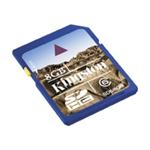SDHC
 SDHC stands for Secure Digital High Capacity. SDHC cards, as the name suggests, provide higher storage capacity in a card with the same form factor as a normal Secure Digital (SD) card. Normal SD cards will work in SDHC-specified slots, but SDHC cards won't be recognized by older SD slots. SDHC cards first appeared in 2006. SDHC cards are generally formatted with the FAT32 file system (while normal SD cards generally use FAT16) and use sector addressing instead of byte addressing. SDHC cards have a fixed sector size of 512bytes.
SDHC stands for Secure Digital High Capacity. SDHC cards, as the name suggests, provide higher storage capacity in a card with the same form factor as a normal Secure Digital (SD) card. Normal SD cards will work in SDHC-specified slots, but SDHC cards won't be recognized by older SD slots. SDHC cards first appeared in 2006. SDHC cards are generally formatted with the FAT32 file system (while normal SD cards generally use FAT16) and use sector addressing instead of byte addressing. SDHC cards have a fixed sector size of 512bytes.
The SD Card Association (SDA) has placed a limit of 32GB on SDHC capacity, while technically speaking it could support up to 2 terabytes (TB) of storage if it could be developed. SDHC cards emerging onto the market created considerable consumer confusion as normal SD cards are used for many portable devices including digital cameras, camcorders, game systems, MP3 players etc., almost all of which didn't initially support SDHC cards. It was particularly confusing because 4GB SDHC cards were released when 4G SD cards were also being marketed.
SDHC cards are also graded by speed in three classes. Generally speaking, Class 2 offers 2 MB/s, Class 4 offers 4 MB/s and Class 6 offers 6 MB/s.
There are a variety of Secure Digital (SD) products available..
Secure Digital (SD) --> Original SD card offering capacities up to 8GB currently.
miniSD --> A smaller form-factor version of the original SD card.
microSD --> Currently the smallest flash memory card on the market.
miniSDHC --> High Capacity version of miniSD card.
microSDHC --> High Capacity version of microSD card.
SD plus --> A form of SD card developed by SanDisk.with USB additions.
Eye-Fi --> An SD card with built in Wifi capabilities of its own.
Gruvi --> A form of SD card developed for content distribution by SanDisk.

